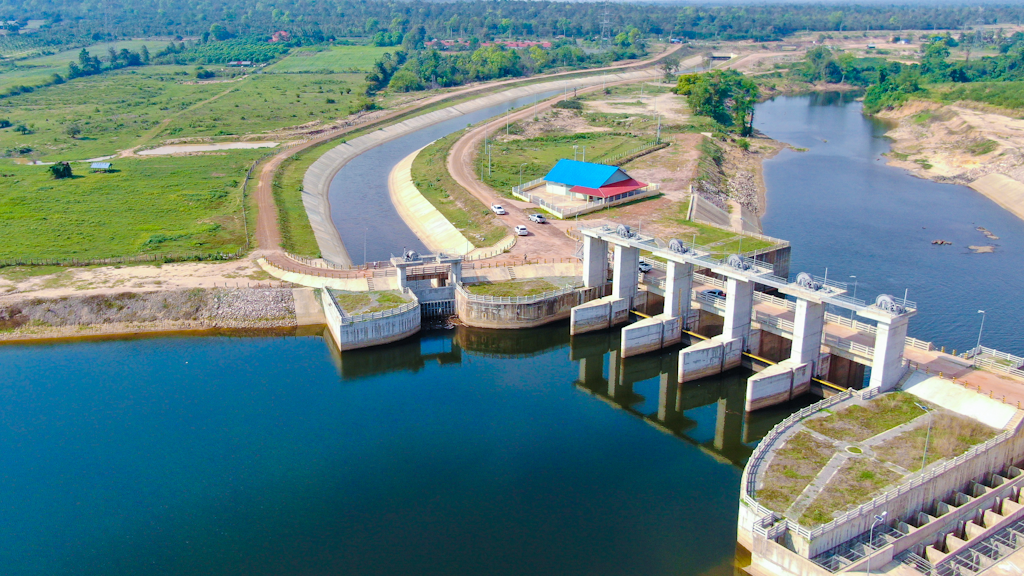Case Study: GMS Flood and Drought Risk Management and Mitigation Project

The main water control facility of the Damnak Chheukrom Mega Irrigation System in Pursat, Cambodia. Photo: Ministry of Water Resources and Meteorology via ADB
The Greater Mekong Subregion Flood and Drought Risk Management and Mitigation Project was approved by the Asian Development Bank (ADB) in December 2012 to support the Government of Cambodia in undertaking measures to prepare for and manage disaster risks linked to floods and droughts. Completed in February 2022, the project supported the rehabilitation of the Damnak Chheukrom Mega Irrigation System. This has improved the lives of an estimated 8,000 households in fifty villages in Pursat, the country’s fourth largest province. The project reduced the occurrence of seasonal flash floods during the rainy season and designed measures to redirect a large amount of water into local lakes for farming and household use during both the wet and dry seasons. It also provided training on disaster management and response plans for the local communities to mitigate the impacts of flooding and drought on their families and farms. Read on for the case study originally featured on the ADB website.
Cambodia’s Rice Farmers Reap Gains from Newly Improved Irrigation System
Nhim Lon, a rice farmer in Talou Sen Shey District in the western province of Pursat in Cambodia, is reaping the benefits of a newly improved mega irrigation system. The rehabilitation of the Damnak Chheukrom Mega Irrigation System by the Asian Development Bank’s (ADB) under its Greater Mekong Subregion Flood and Drought Risk Management and Mitigation Project is serving the needs of some 8,000 households in fifty villages in the country’s fourth largest province.
“Once the irrigation system became operational, I was able to secure my crop against flood damage and produce an extra crop in the dry season,” he said. “Now that we have assured water, many people in my community have stopped migrating to other areas to look for jobs.”
Som Sam, a fellow rice farmer in the neighboring district of Phnom Kravanh, echoed the sentiment.
“Earlier, floods and droughts and lack of water always worried us. Almost all farmers were discouraged by this uncertainty,” he said.
Rice farmers like Nhim Lon and Som Sam can now produce an average of 4 to 5 tons of rice paddy per harvest per hectare and can generate as many as three harvests annually. Prior to the rehabilitation of the irrigation system, farmers made do with only one yearly harvest consisting of 1 to 2 tons of rice paddy.
The project was primarily designed to reduce seasonal flash floods in the Pursat province during the rainy season and redirect a large amount of water into local lakes for farming and household use during both the wet and dry seasons. It also assisted in training the local communities on disaster management and response plans to mitigate the impacts of flooding and drought on their families and farms.
The Ministry of Water Resources and Meteorology undertook the rehabilitation of the irrigation system with the Department of Hydrology and River Works and the Provincial Department of Water Resources and Meteorology of Pursat province. The project costs about $31 million, of which 5% was financed by the government and 73% by an ADB loan. The balance was covered by a Strategic Climate Fund (a trust fund established and administered by ADB to finance pilot innovative approaches or to scale-up activities to address climate issues) loan of $4.0 million and an SCF grant of $5.8 million.
Bak Bunna, Deputy Director of the Department of Water Resource Management and Preservation at the Ministry of Water Resources and Meteorology, said the system irrigates a total of 16,100 hectares of farmland in the Talou Sen Shey and Phnom Kravanh districts of Pursat. The system is capable of redirecting and storing large amounts of water during the wet season and preserving water for use in the dry season. It has a main canal that runs for 16.5 kilometers, supported by secondary and tertiary canals of around 70 kilometers.
The project set up water user communities, each comprising about 80 farmer representatives, to join hands with the local authorities to manage the irrigation system and weigh in on operational decision-making.
“Apart from the infrastructure that it creates, the project touches the lives of the communities it serves. It brings them together to discuss problems and contribute to maintaining the irrigation system. The project fosters a shared sense of belonging and prosperity,” said ADB Country Director for Cambodia Jyotsana Varma after talking to project beneficiaries at one rehabilitated site, government partners, and local authorities.
Last Updated: 11 January 2024
